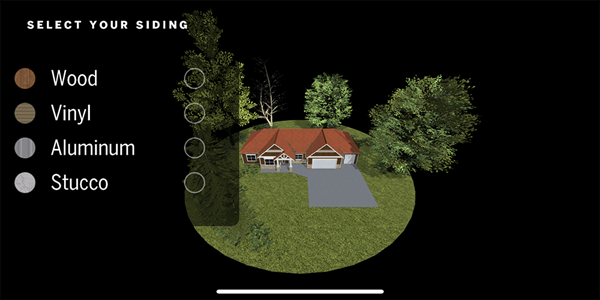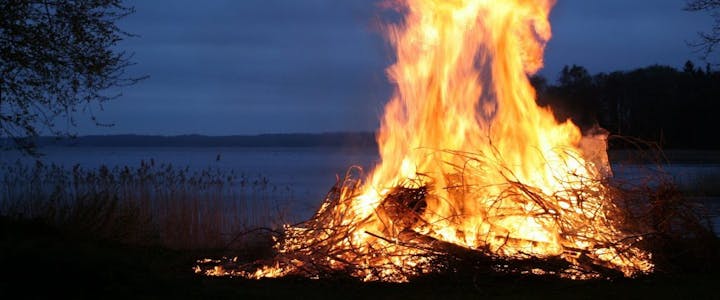Preparing for Wildfire
Understanding WILDFIRE
Not a New Phenomenon
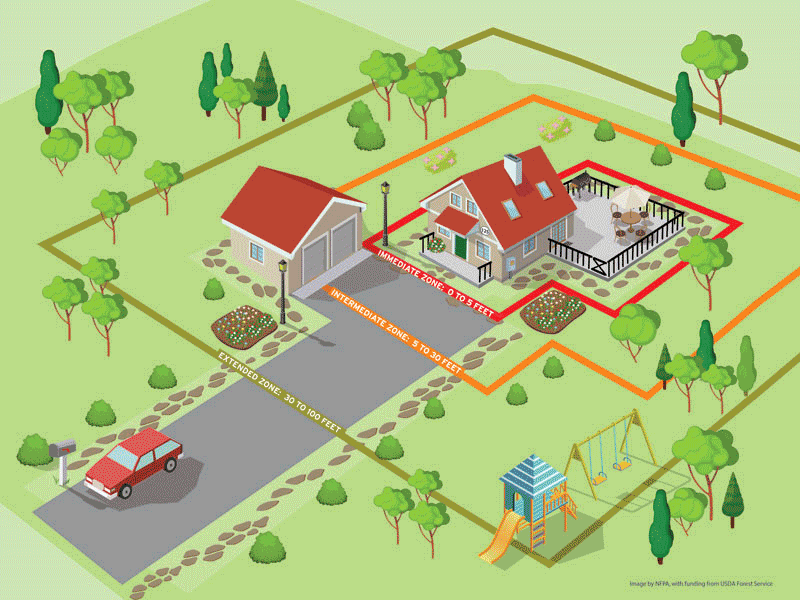
Wildfires are inevitable — and for the over 74 thousand households and over four thousand businesses with employees at risk of wildfire in El Dorado County, these natural occurrences pose a significant threat.
Wildfires are, and always have been, a natural part of a healthy ecosystem. Fire burns away dead brush and debris, leaving behind a healthy and clean environment. Wildfire thins out overgrown plants and even welcomes new seeds and plants to an area. In the past 100 years, the 6,426 population of the county has increased thirty times to the nearly 200,000 residents today. In the early 1900's, the California Gold Rush had moved El Dorado County into collected communities supporting timber harvest, mining, crop production, and livestock grazing.
Because wildfires were something that mostly happened in the forests, NFPA’s 1935 standard on fire protection and prevention for summer homes described vulnerable structures of the time as – cabins in the woods. Over the next 50 years, with post-war residential construction accelerating across the nation to house a growing population, wildfire was not recognized as a potential threat. El Dorado County was no exception to this expansion. Now, many local residents live, work and travel through areas vulnerable to wildfire.
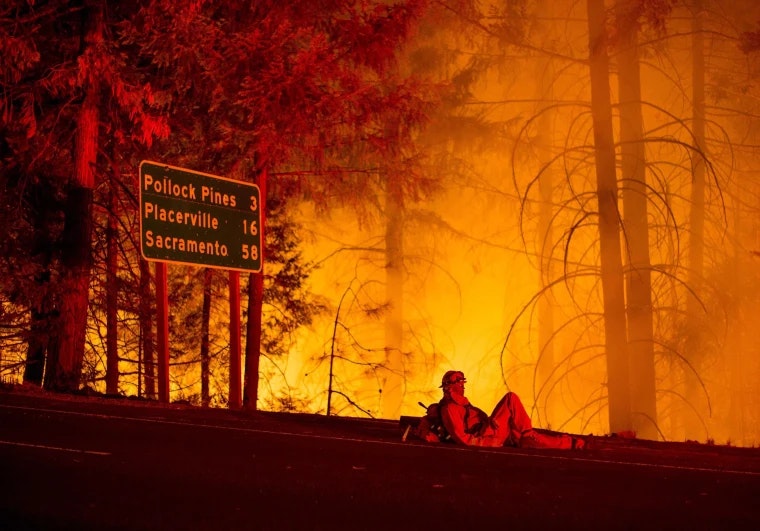
85% of wildfires are human caused. The leading human causes of fires are: unattended campfires, equipment use or malfunction (welding or sparks, mowing equipment, dragging chains, catalytic converter failure, and even power line problems), debris burning, fireworks, careless discarding of cigarettes, car fires or tire blowouts and lastly, arson. Carelessness is a big factor in human caused wildfires.
Natural wildfires in this area are overwhelmingly caused by lightning.

Firefighters can bear witness to the fact that wildfires have been increasing in frequency and severity over the past decade. Our dry Mediterranean climate combined with more frequent drought and higher than average temperatures are contributing to increased wildfire risk. Just because we have to accept that wildfires will continue to exist, doesn't mean that we have to accept continuing destruction of property. “All Hands, All Lands,” is the approach we need to take for landscapes and communities at risk. By understanding wildfire and how to best protect you property you can take steps to reduce risk to you homes and businesses.
Fire Preparation Tool Kit_v5.pdf
Just because we have to accept that wildfires will continue to exist, doesn't mean that we have to accept continuing destruction of property.
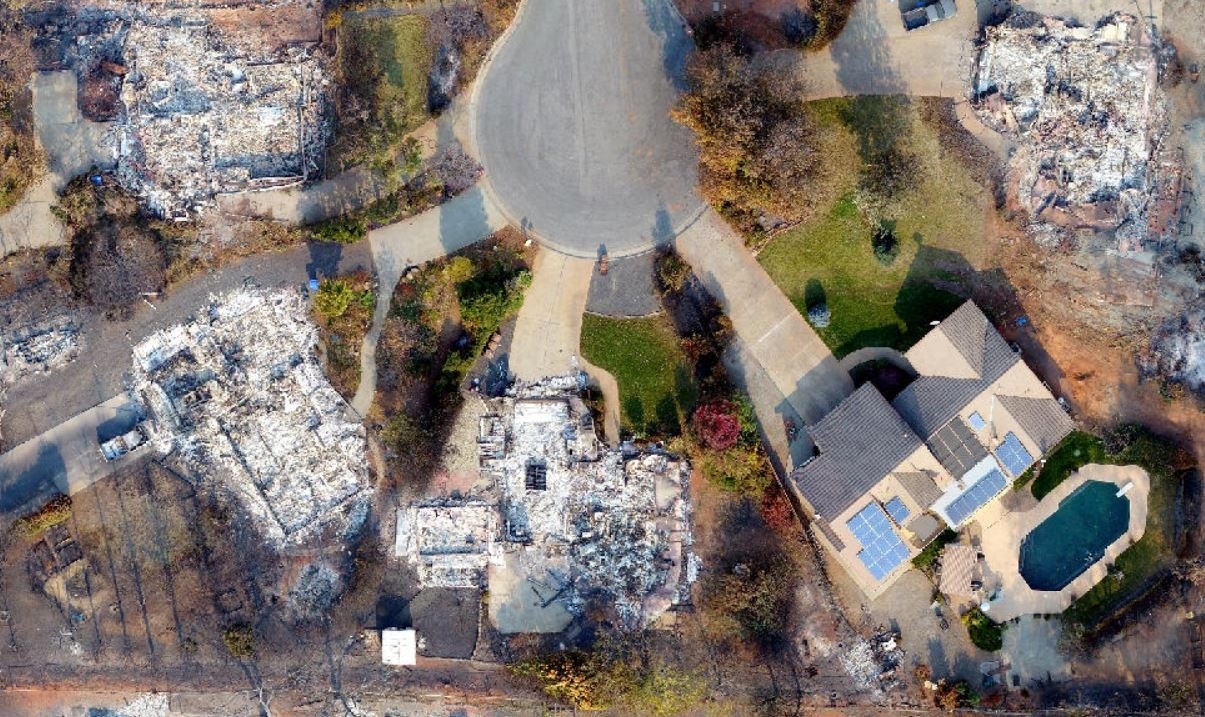
People often misunderstand the cause of structural damage from wildfires. As seen from the "miracle house," fires don't sweep through entire communities and neighborhoods. There are many factors and conditions of wildfires that leave unmitigated structures vulnerable to ignition.
Rapid Fire Spread — After a fire ignites, severe conditions such as extreme heat, drought, and wind can cause the fire to spread rapidly, igniting vast developed areas.
Multiple Simultaneous Ignitions — A fire disaster requires the presence of ignitable structures. Extreme wildfire conditions can expose a wide area to embers and flames, generating simultaneous ignitions to hundreds of highly ignitable homes and businesses.
Overwhelmed Fire Suppression — Extreme wildfire cannot be controlled, and more structures could be exposed to ignition and burning than there are structure protection resources, such as firefighters and apparatus, to protect them.
Not all wildfires behave the same way. Some fires burn hot and intense, creating a vast amount of destruction, while other fires burn with low intensity, burning away debris and dead plant but leaving behind living vegetation. It is important to note both high-intensity and low-intensity wildfire can destroy vulnerable structures.
High-intensity fires are difficult for firefighters to contain. In forests, they often reach the tree crown, producing embers that can be carried aloft by superheated air or wind.
Just because a wildfire is low-intensity, doesn't mean structures cannot ignite, and just because a wildfire is high-intensity doesn't mean structures cannot survive.
Convection
Hot air rises, which allows heat transfer to occur through convection. Convective currents are made up of hot gasses and fire from wildfire, which can lift embers (sometimes called firebrands) into the air and deposit those embers a mile or more from the flame front; this is the most common way wildfires spread. Embers are hot pieces of debris that break away from a fire. Burning embers are caught up in the convective column, which allows them to drift miles away from the initial fire.
Embers break off from burning debris and are carried through the air – possibly for more than a mile, creating new spot fires, thus perpetuating the cycle. Some embers come from vegetation while others detach from burning structures; the source of the ember may impact how long it smolders and poses a threat.
Should a hot ember land in a pile of debris or on a vulnerable roof, it could quickly spark a new fire. Even areas that are not considered high wildfire risk can be threatened by embers. Burning embers are the most significant threat to property. The roof is often the part of a structure that is most vulnerable to ignition, due to its large surface area and vulnerability to debris accumulation. However, there are a variety of other ways embers can ignite structures—from vents to fences.
Radiation
Imagine sitting in front of a warm fireplace. The waves of heat that you feel coming from the flames are radiation; the parts of you directly facing the heat source are warmed. If enough heat is radiated at a fuel source, eventually, the fuel could reach a temperature where it will ignite. This is a primary source of structural ignition.
Glowing combustion (embers), over very small distances, and flaming combustion, over greater distances, are two radiant heat sources that can ignite nearby structures and vegetation. In most cases, radiant heat from wildfire flames (flaming combustion) will not ignite structures over 30 ft away from the flame front.
Crown Fires and Surface Fires
Although not the most common way wildfire spreads to structures, wildfire can spread through crown fires and surface fires.
Crown fires are large flames burning in the tops or canopies of trees. These large flames radiate heat that can ignite wood walls from up to 100’ away. Other types of large flames can come from detached buildings, burning wood piles and ignited vehicles.
Surface fires are typically small flames burning through grass and ground litter. They can reach houses or attachments if there’s no interruption in the types of fuel sources. Flames touching a house, fence or deck can cause them to ignite.

Defensible Space: Defensible is Defendable
Steps you can take to protect your home or business

Research around home destruction vs. home survival in wildfires point to embers and small flames as the main way that the majority of homes ignite in wildfires. Embers are burning pieces of airborne wood and/or vegetation that can be carried more than a mile through the wind can cause spot fires and ignite homes/structures, debris and other objects.
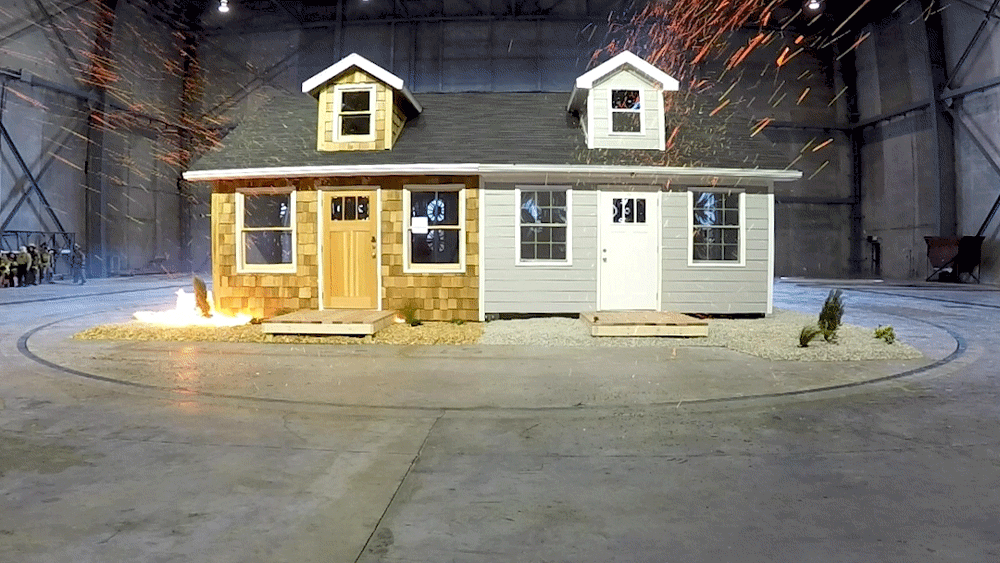
There are methods for homeowners and business owners to prepare their properties to withstand ember attacks and minimize the likelihood of flames or surface fire touching the home/structure or any attachments. Experiments, models and post-fire studies have shown homes/structures ignite due to the condition of the home/structure and everything around it, up to 200’ from the foundation. This is called the Home Ignition Zone (HIZ). These concepts apply to businesses too.
The concept of the home ignition zone (applicable to commercial buildings too) was developed by retired USDA Forest Service fire scientist Jack Cohen in the late 1990s, following some breakthrough experimental research into how homes ignite due to the effects of radiant heat. The HIZ is divided into three zones.

Immediate zone — Zone 0
The home/building and the area 0-5’ from the furthest attached exterior point of the home; defined as a non-combustible area. Science tells us this is the most important zone to take immediate action on as it is the most vulnerable to embers. START WITH THE HOUSE ITSELF then move into the landscaping section of the Immediate Zone.

- Clean roofs and gutters of dead leaves, debris and pine needles that could catch embers.
- Replace or repair any loose or missing shingles or roof tiles to prevent ember penetration.
- Reduce embers that could pass through vents in the eaves by installing 1/8 inch metal mesh screening.
- Clean debris from exterior attic vents and install 1/8 inch metal mesh screening to reduce embers.
- Repair or replace damaged or loose window screens and any broken windows Screen or box-in areas below patios and decks with wire mesh to prevent debris and combustible materials from accumulating.
- Move any flammable material away from wall exteriors – mulch, flammable plants, leaves and needles, firewood piles – anything that can burn. Remove anything stored underneath decks or porches.
Intermediate zone — Zone 1
5-30’ from the furthest exterior point of the home. Landscaping/hardscaping- employing careful landscaping or creating breaks that can help influence and decrease fire behavior
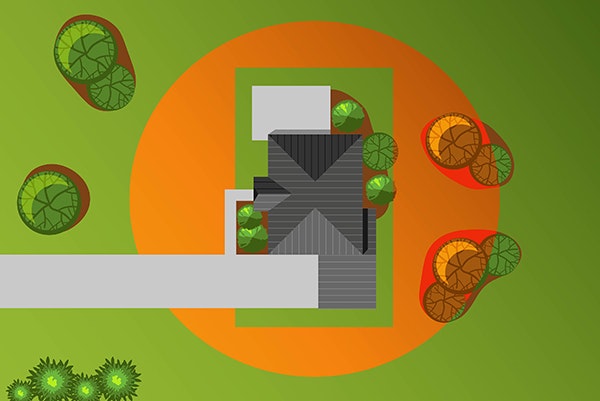
- Clear vegetation from under large stationary propane tanks.
- Create fuel breaks with driveways, walkways/paths, patios, and decks.
- Keep lawns and native grasses mowed to a height of four inches.
- Remove ladder fuels (vegetation under trees) so a surface fire cannot reach the crowns. Prune trees up to six to ten feet from the ground; for shorter trees do not exceed 1/3 of the overall tree height.
- Space trees to have a minimum of eighteen feet between crowns with the distance increasing with the percentage of slope.
- Tree placement should be planned to ensure the mature canopy is no closer than ten feet to the edge of the structure.
- Tree and shrubs in this zone should be limited to small clusters of a few each to break up the continuity of the vegetation across the landscape.
Extended zone — Zone 2
30-100 feet, out to 200 feet. Landscaping – the goal here is not to eliminate fire but to interrupt fire’s path and keep flames smaller and on the ground.
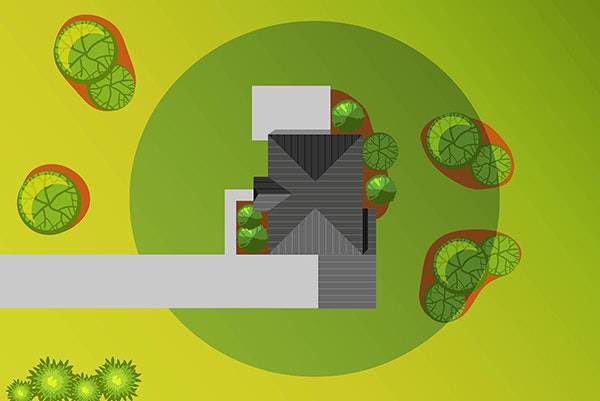
- Dispose of heavy accumulations of ground litter/debris.
- Remove dead plant and tree material.
- Remove small conifers growing between mature trees.
- Remove vegetation adjacent to storage sheds or other outbuildings within this area.
- Trees 30 to 60 feet from the home should have at least 12 feet between canopy tops.*
- Trees 60 to 100 feet from the home should have at least 6 feet between the canopy tops.*
*The distances listed for crown spacing are suggested based on NFPA 1144. However, the crown spacing needed to reduce/prevent crown fire potential could be significantly greater due to slope, the species of trees involved and other site specific conditions. Check with your local forestry professional to get advice on what is appropriate for your property.


Downslope Extended Zone
In areas of Extra High Fire Hazard this zone will extend to 200 feet from your home. The goal of this zone is to dramatically diminish and slow a fire.

When Your Home Ignition Zone Extends Into Neighboring Properties
You may find your home ignition zone overlaps into adjacent properties. To maximize the benefits of your work, it’s extremely important to work collaboratively with neighbors to reduce your shared risk.

Ignition resistant building materials, construction techniques, along with vegetation and debris removal, play a vital role during wildfires.
First Priority
- CARPORTS: Remove flammable items stored in carports.
- DECKS AND ELEVATED PORCHES: Place 1/8” metal mesh screening between low profile decks from surface to ground, to block embers from collecting underneath. Never store flammable materials underneath elevated decks/porches. Remove dead vegetation and debris from under decks/porches, and between deck board joints.
- FENCING: Use non-flammable fencing material (metal or masonry) when attaching directly to the siding. Ensure there’s a minimum of at least 5’ of noncombustible material where it attaches to the siding. Do not add vines or other types of vegetation to fencing material. Wooden fences can carry flames directly to the house.
- FIREPLACE CHIMNEYS: Remove debris that may accumulate at roof-to-wall intersections. Embers from a fireplace can exit the chimney and could ignite a wildfire; to prevent this install a spark arrestor. When wildfires are approaching close the damper, fireplace screens and glass doors.
- GUTTERS: Metal roof gutters do not ignite, only the debris material that accumulates in them – that’s why keeping them clean is so important. Vinyl roof gutters can ignite when the debris material is ignited and flaming gutters can fall from the roof edge and land next to the house, which is why the immediate zone needs to be clear of flammable materials.
- ROOF MAINTENANCE: Keep roofs clean from leaf litter and pine needles. Remove all tree limbs within 10 feet of the chimney, or that overhang the roof.
- SIDING: Use ignition-resistant building materials on exterior walls. Examples include: Stucco, masonry products, plaster and cement. Seal gaps and crevices. Examine the siding for locations where embers could accumulate or lodge and apply caulking at trim-to-siding locations where it is missing or has failed.
Second Priority
- EAVES AND SOFFITS: Reduce the size and number of embers that pass through vents in the eaves by covering them with a 1/8 inch metal mesh screening. Inspect soffit vents and maintain as needed.
- CRAWL SPACES: Remove combustible materials and install 1/8” mesh screening on vents.
- FOUNDATION: All foundation vents should have a 1/8 inch corrosion-resistant metal screening.
- GARAGES: Weather seal the perimeter of garage doors to help keep embers out. Be sure the door is tight fitting so embers can’t slide under the door or in from the sides. If possible, choose a metal or wood core door with metal exterior.
- SLIDING GLASS DOORS: Choose double-pane tempered glass. Consider fireproof shutters to protect large windows and glass doors from radiant heat.
Third Priority
- ROOFING MATERIALS: Types of Class A fire-rated roofing products offer the best protection. Examples include: Composite shingles, metal, cement tile and clay. Inspect shingles/tiles and replace/repair those that are loose or missing to prevent ember penetration. If gaps exist between the roof covering and the roof deck at the eave or ridge, fill the space with a “bird stop” material.
- SKYLIGHTS: Remove debris next to and on skylights. Glass is a better option than plastic or fiberglass.
- VENTS: Consider purchasing closure devices for foundation and gable end vents and installing a louver- type dryer vent that stays closed unless the dryer is running. Clean debris from attic vents and install 1/8 inch metal mesh screening. For turbine vents, access the attic and inspect where the vent attaches to the roof and attach 1/8 inch screening to the roof sheathing. Dormer-face vents should be replaced with a low-profile vent. Ridge vents should be rated for high wind/rain exposure.
- WINDOWS: Multi-paned tempered glass can help reduce the risk of fracture or collapsing in a wildfire.
- Add color and interest with high moisture content plants in containers that could be easily moved to the Intermediate zone when wildfires are approaching.
- Addresses should be visible from the road. (at least 4" numbers, contrasting with background, reflective is best)
- Closable foundation and gable end vents should be shut when threatened by a wildfire and reopened after the danger passes.
- Close and protect home openings, including attic and basement doors and vents, windows, garage and pet doors to prevent embers from gaining access to the home.
- Connect garden hoses, fill pools, hot tubs, garbage cans or other large containers with water and place ladders outdoors. Firefighters have been known to use hoses, ladders and water sources to extinguish spot fires.
- Consider installing non-flammable shutters similar to hurricane shutters.
- Consider using noncombustible deck boards (metal and fiber cement), or a solid light weight concrete.
- Incorporate a mixture of deciduous and conifer trees.
- Install a garage door on both attached and detached garages.
- Move vehicles into a non-combustible area (gravel or concrete) and roll-up all windows.
- When wildfire threat is high, move patio/deck furniture, cushions, door mats and potted plants indoors, or as far away from the home, shed and garage as possible when wildfire warnings are received.
In addition to the 100' around your home, it is important to also manage vegetation along private driveways and, if your property boarders a road, the roadway too. Clearing along roadways makes access safer for emergency vehicles and, if you are evacuating from a rapidly approaching wildfire, also improves your chances of getting out safely. When evacuations occur traffic can back up along roadways slowing those escaping — even more reason to clear hazardous vegetation, providing more resiliency for you and your neighbors.
- Remove all vegetation within 10' of roadways, except ground cover vegetation less than 18" tall.
- Remove all brush and ladder fuels.
- Trees larger than 24" diameter should be limbed 15' up.
- All trees overhanging a driveway or road should be trimmed up to 15' clearance for vehicles.
- Remove any invasive species plants, especially Scotch or Spanish brooms.
- for information on invasive species visit California Native Plant Society - El Dorado Chapter
- Do not install speed bumps/undulations, traffic spikes or other devices that slow emergency vehicles or evacuations.
- Remember that emergency vehicles may be entering when you are exiting.
- Address numbers should be visible from the main roadway. Firefighters responding to your neighborhood may not be familiar with local properties, roads and access points and often are driving your streets at night or in smoky conditions. If we can't find you, we can't help you.
- Address numbers should be:
- At least 4" on roadways with speeds 25 mph or less.
- At least 6" on roadways with speeds greater than 25 mph.
- Signs should be at least 4' above grade and kept clear of weeds, snow and other debris that can obstruct the signs.
- Signs should be highly reflective and the text shall contrast with the background color.
- Address numbers should be:

- Street Name Signs should be present to identify important roads that are not otherwise marked, such as private roads.
- Signs should be highly reflective and the text shall contrast with the background color.
- Signs should follow the California Manual on Uniform Traffic Control Devices (CA MUTCD) standards. Boarders on these signs are optional.
- Lettering should be composed of both upper-case and lower-case letters. Initial letters should be upper-case.
- Upper-case letters should be:
- At least 4" along streets with speed limits up to 25 mph.
- At least 6" along streets with speed limits 26-40 mph.
- At least 8" along streets with speed limits greater than 40 mph.
- Signs shall be mounted with their faces parallel to the street they name.
- Signs shall be clearly visible to traffic approaching from all directions.
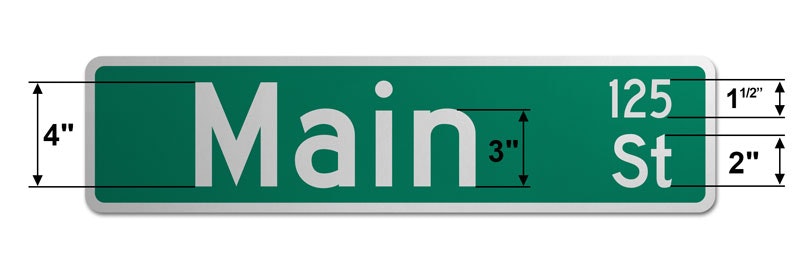
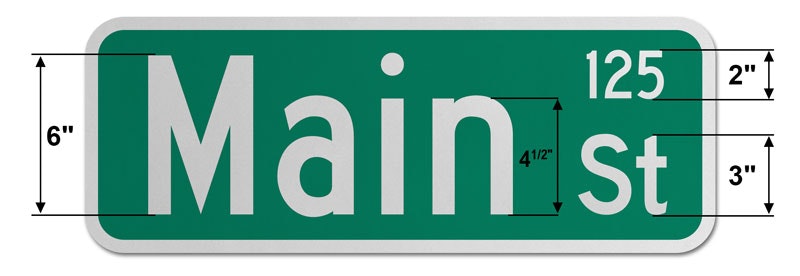
Ready For Wildfire
CAL FIRE's guide to Plan, Know and Act in response to wildfire.
https://www.readyforwildfire.org/
Ready.gov Wildfires
FEMA's comprehensive guide to creating an emergency plan and taking wildfire preparedness steps.
https://www.ready.gov/wildfires
NFPA Wildfire
Find online training, apps and more resources to help to understand wildfire and how it can impact you.
Firewise USA
National recognition program for voluntary community wildfire risk reduction action.
https://www.nfpa.org/Public-Education/Fire-causes-and-risks/Wildfire/Firewise-USA
Outthink Wildfire
NFPA wildfire policy actions
https://www.nfpa.org/wildfirepolicy
Wildfire Retrofit Guide
Specific recommendations for how to retrofit existing components of a home to withstand wildfire.
https://naes.agnt.unr.edu/PMS/Pubs/2020-3810.pdf
Insurance Institute for Business & Home Safety
Insurance Institute for Business & Home Safety's wildfire guidance for home and business owners
https://disastersafety.org/wildfire/
El Dorado County Fire Safe Council
Protecting the people of El Dorado County and their property from the effects of catastrophic wildfire through education, cooperation, innovation, and action.
El Dorado County Agricultural Commission
Invasive weeds are everyone's responsibility, and we need your help to eradicate them. Find information on how you can take steps to help combat invasive weeds.
https://www.edcgov.us/Government/ag/Pages/invasive_weeds.aspx
Videos
Your Home and Wildfire. Choices That Can Make a Difference.
How Do Homes Burn in a Wildfire?
The Relationship Between Extreme Heat and Wildfire
Remember… creating defensible space is YOUR responsibility and it is required by law*.
*Compliance to PRC 4291 is required by any person who owns, leases, controls, operates or maintains a building or structure in or adjoining any mountainous area, forest-covered lands, brush-covered lands, grass-covered lands or any land that is covered with flammable material and is within the State Responsibility Area. PRC 4291 requires 100 feet of Defensible Space (or to the property line if less than 100 feet) from every building or structure that is used for support or shelter of any use or occupancy. Owner, lessee or operator must also comply with all existing environmental protection laws and must obtain all necessary permits.



